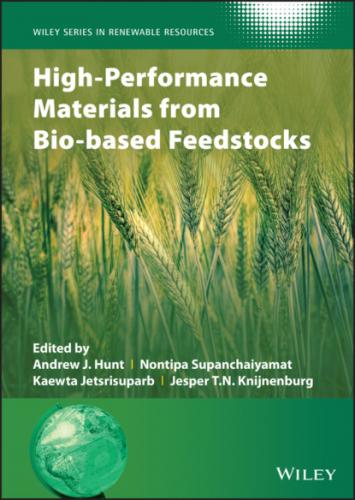A drawback of the sulfonated bio‐based activated carbon catalyst is that its preparation process is environmentally unfriendly owing to the heating of carbon materials in concentrated sulfuric acid for an extended time. Apart from sulfuric acid, tribasic potassium phosphate (K3PO4) was recently used to activate carbon materials. The K3PO4 impregnated on the activated carbon catalyst benefited the biodiesel production from waste cooking oil. With 5% catalyst loading, the biodiesel yield was 98% in a 12 : 1 methanol‐to‐oil molar ratio at 60 °C for four hours. Only 20% reduction in biodiesel yield was observed when the catalyst was used for five reaction cycles [125].
Figure 2.7 Esterification of acetic acid.
One way to further enhance the catalytic activity of bio‐based activated carbon is via impregnation with various metal ions. The Fe3O4 embedded on beetroot‐derived activated carbon catalyst (Fe3O4/BRAC) was examined for its performance in the reduction of nitroarenes as illustrated in Figure 2.8 [126]. The process yielded a high aromatic amines product (99%) even at 85 °C for 15 minutes. The reaction pathway as described in Veerakumar et al. [126] can be briefly summarized as follows: first, the nitrobenzene and isopropanol were chemisorbed on the surface of Fe3O4/BRAC. Hydrogen in the form of hydride ion was transferred from the isopropanol to the substrate. Subsequently, the existence of KOH and the Fe3O4/BRAC catalyst promoted the transformation of alcohol into alkoxide species. The nitro groups on the catalyst surface were reduced to nitrosobenzene, which reacted with hydrogen ion from isopropanol to form aniline. The product desorbed from the catalyst surface in the final step. The immobilization of Fe3O4 on the large surface area activated carbon facilitated the reaction under mild conditions in a short reaction time. The Fe3O4/BRAC catalyst boosted the hydrogen relocation from interacting isopropanol and KOH. Moreover, it presented high stability with less than 10% decrease in aniline yield after five repeated cycles. Importantly, separation of the Fe3O4 impregnated carbon catalyst from the products was readily achieved by an external magnetic field owing to the magnetic properties of Fe3O4.
Lignocellulosic waste‐derived activated carbons impregnated with ZnCl2 (giving Lewis acid sites) or H2SO4 (giving Brønsted acid sites) were very effective for the conversion of glucose to 5‐hydroxymethylfurfural (HMF) through isomerization and dehydration according to pathway 1 presented in Figure 2.9. These catalysts were more productive than homogeneous catalysts (H2SO4 and ZnCl2), even though these contained higher Lewis and Brønsted acid sites than the impregnated activated carbon [127]. This implies that the activated carbon itself had specific catalytic behavior for this reaction. Activated carbon possessed some Lewis and Brønsted acid sites but it had very high specific surface area and high amount of oxygenated functional groups. Therefore, the two latter predominant properties of the activated carbon strongly affected its catalytic efficiency. Its large specific surface area might increase the opportunity for adsorption of reactants on the active site. The large amount of oxygen functional groups on its surface might cooperate in the fructose dehydration to HMF.
It is well known that KOH activation before metal impregnation increases the surface area and pore volume of the carbon, particularly the micropore volume. The metallic K interposes itself between the carbon structure, leading to permanent enlargement of the carbon lattice after the removal of potassium metal. Thus, it is capable of increasing both the catalytic activity and the stability of the metal‐impregnated carbon catalysts in many reactions, e.g. Mizoroki–Heck, Suzuki, and Sonogashira coupling reactions, toluene steam reforming, and methanation [128–130]. Even if the KOH activator can intensively improve the surface area and porosity of carbon, it requires a relatively high activation temperature. Alternatively, H3PO4 is an interesting activator that requires a lower activation temperature [131]. The H3PO4 was used to activate olive stone at room temperature before carbonization, followed by wet impregnation with zirconium, and the resulting catalyst was employed in methanol dehydration to dimethyl ether [132]. This preparation method produced a superb mesoporous structure and large surface area (1190 m2 g−1) despite the activation occurring at room temperature. Additionally, the extensive formation of active zirconium phosphate functional groups over the surface area of carbon was observed. The catalyst presented both a high conversion in methanol dehydration and high selectivity to dimethyl ether. An increase in the H3PO4 activation temperature along with the addition of NaBH4 promoted the microporous area and the total surface area of the activated carbon (2559 m2 g−1) [133]. Activated carbon was widely employed as a support for several metal catalysts such as nanoparticles of Co, Ni, Cu, and noble metals. These catalysts were effective in bio‐oil hydrodeoxygenation and hydrogen production via both biomass hydrolysate reforming and ammonia borane hydrolysis [131, 134, 135]
Figure 2.8 Reduction of nitrobenzene.
Figure 2.9 Conversion of glucose to 5‐hydroxymethylfurfural.
2.5.4 Hydrothermal Bio‐based Carbons
A green hydrothermal carbonaceous material was developed from by‐products of sugar dehydration in hot compressed water at 150–250 °C [136, 137]. Hydrothermal carbon has been used not only in catalysis but also in agriculture, energy storage, and adsorption. Hydrothermal reaction mechanisms comprise dehydration and decarboxylation, and the process parameters such as reaction temperature and type of biomass
